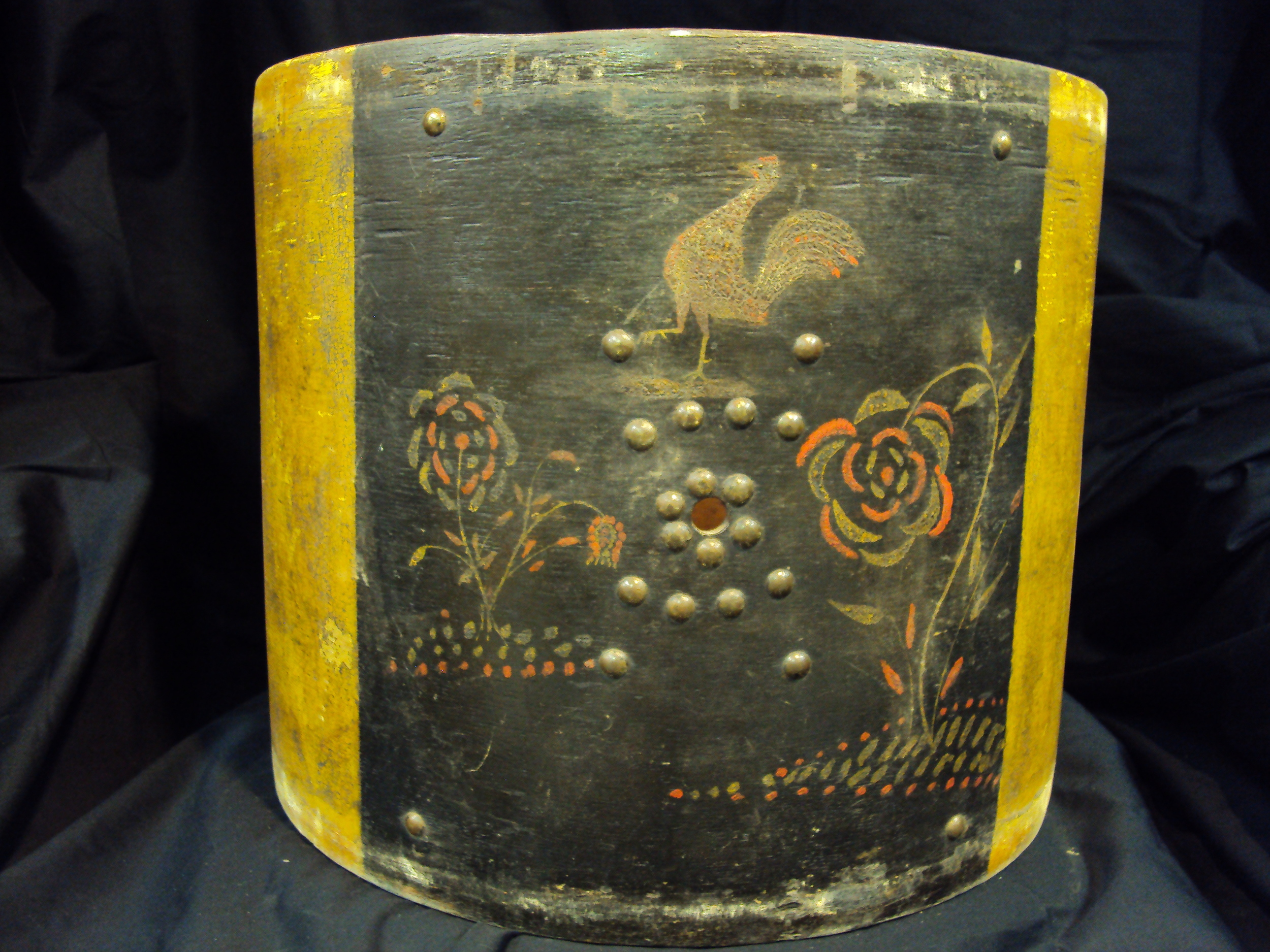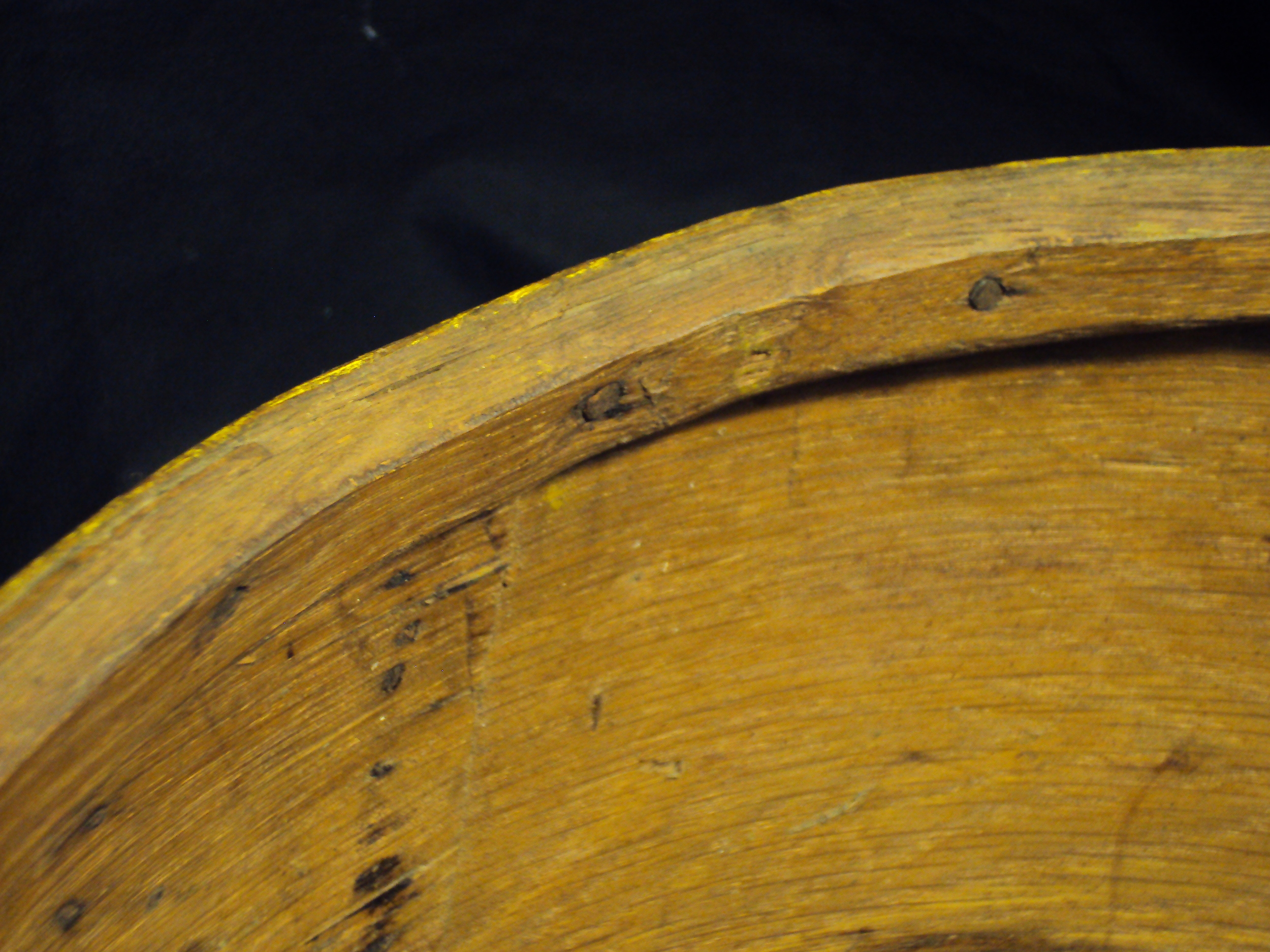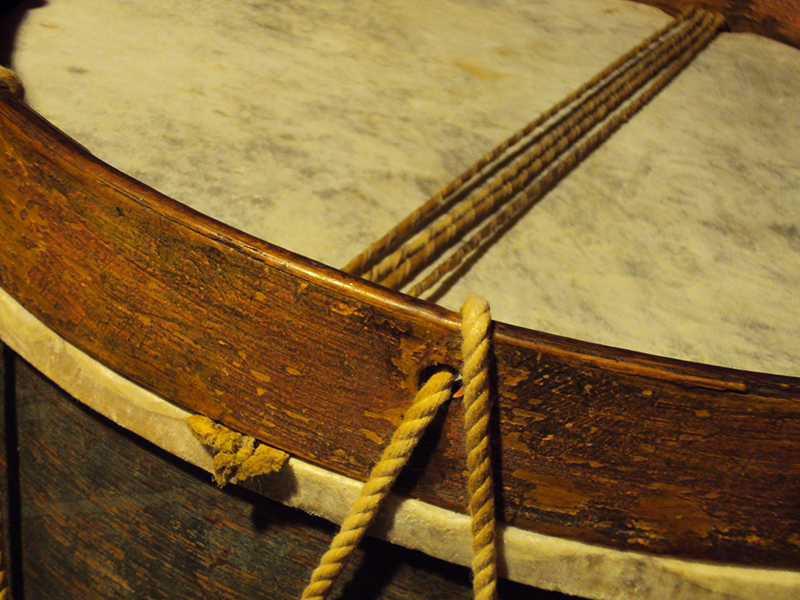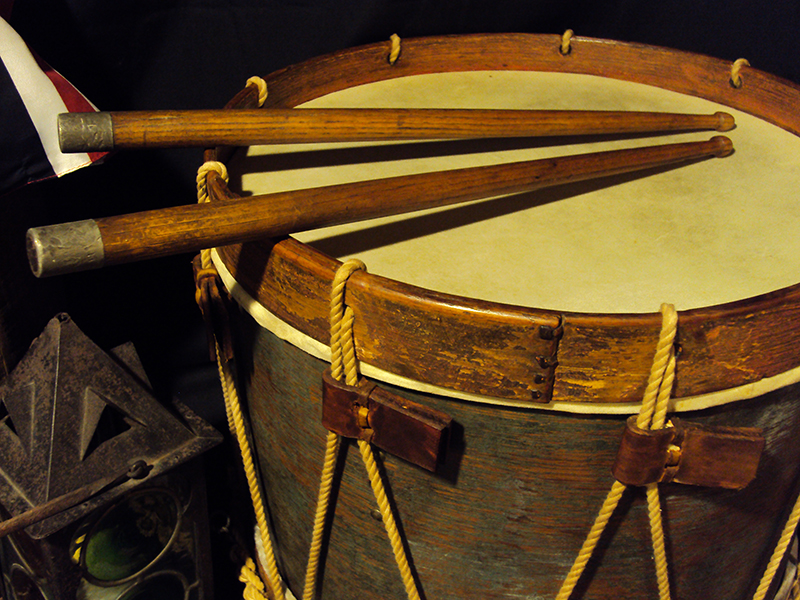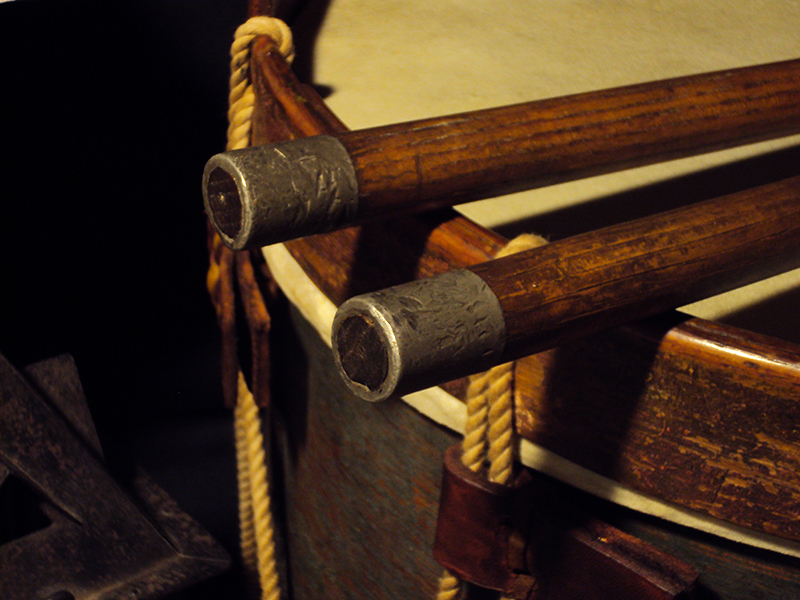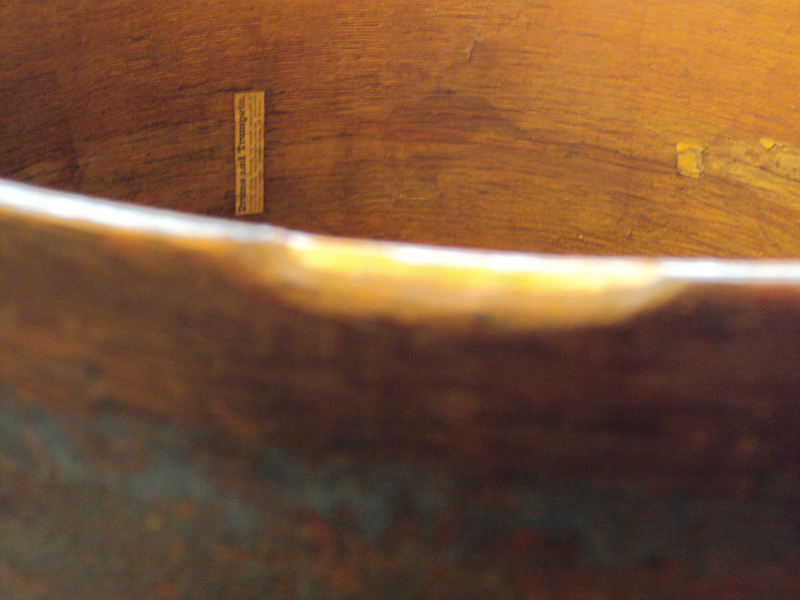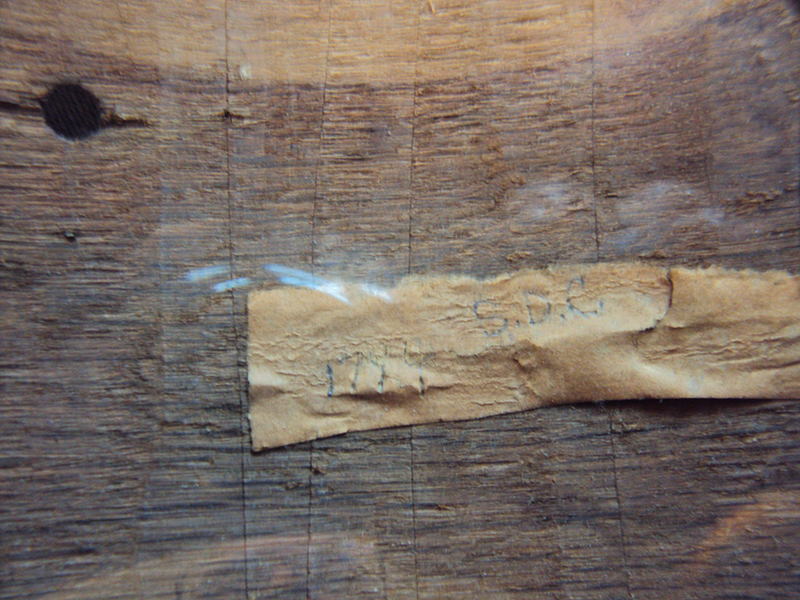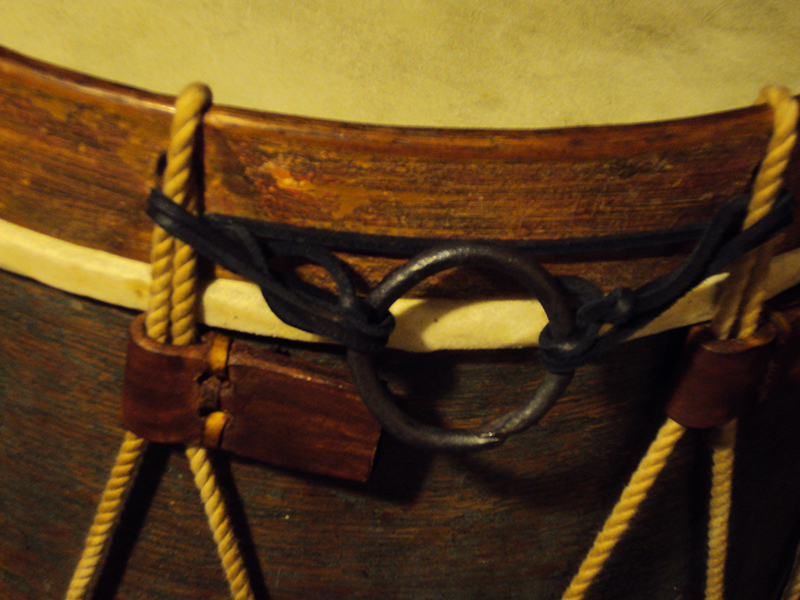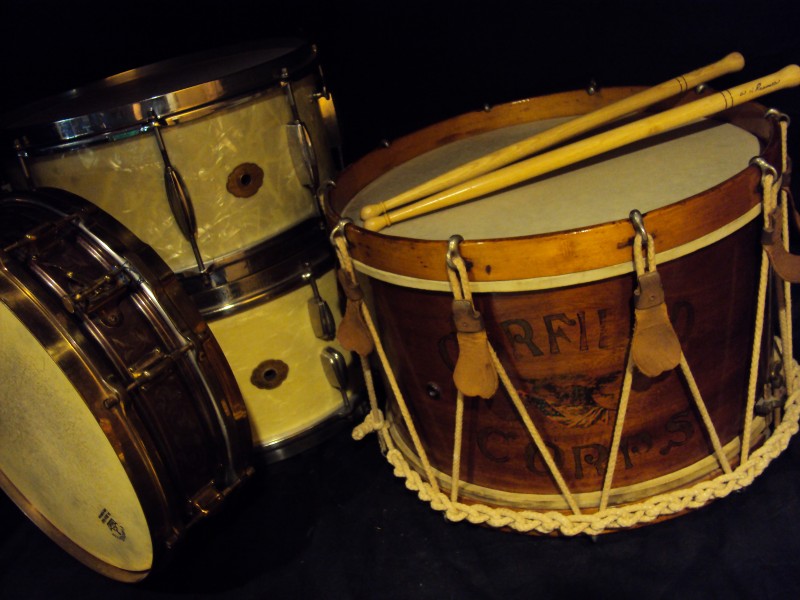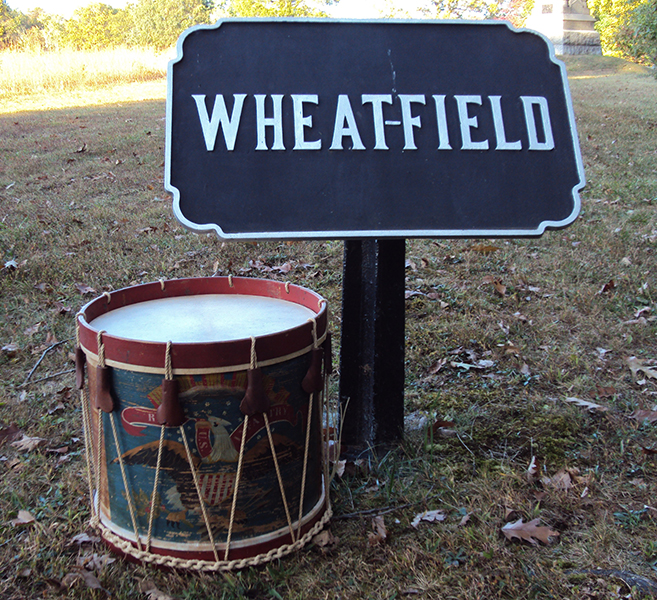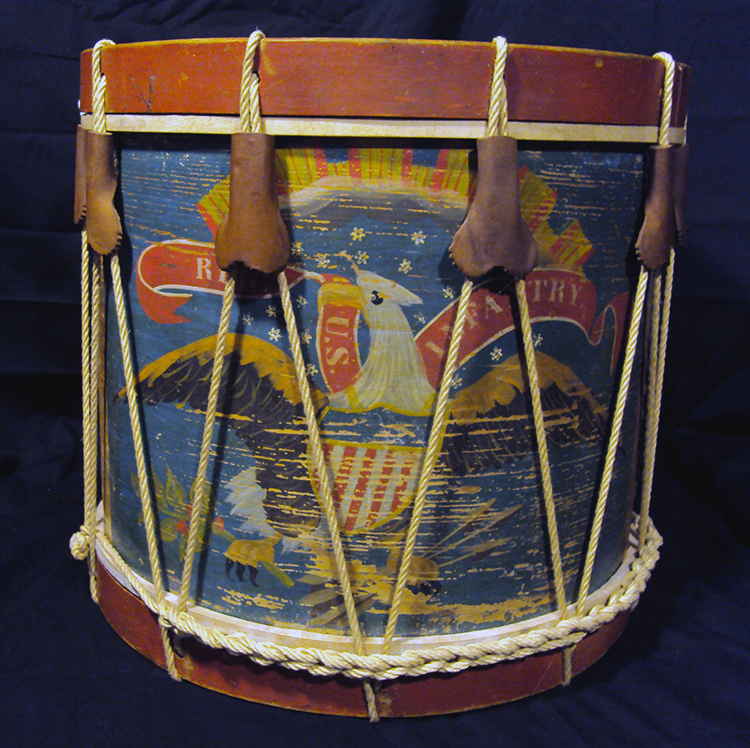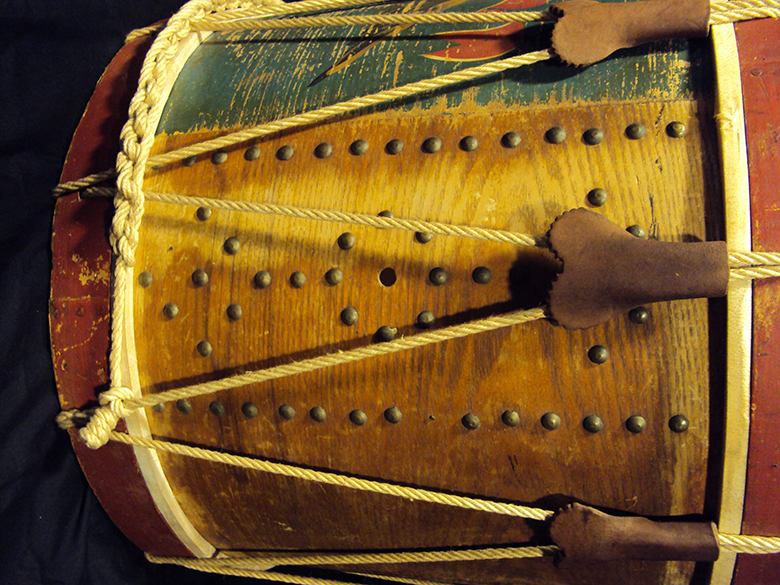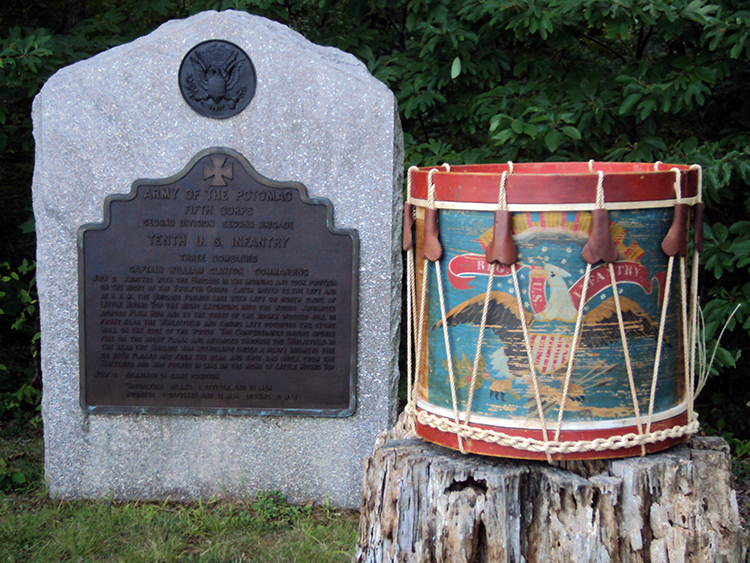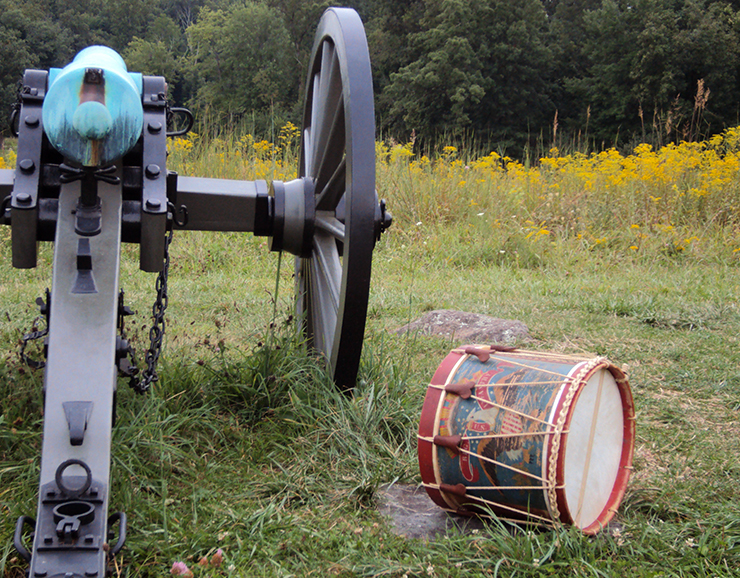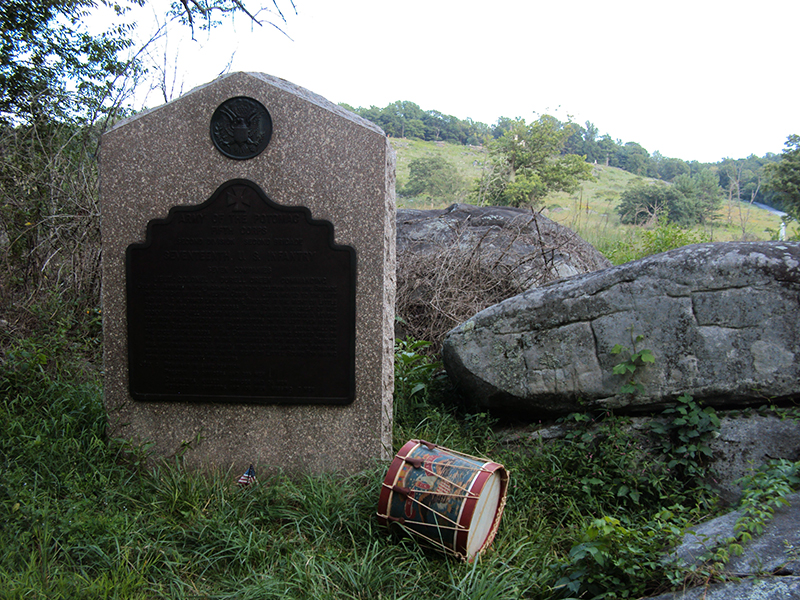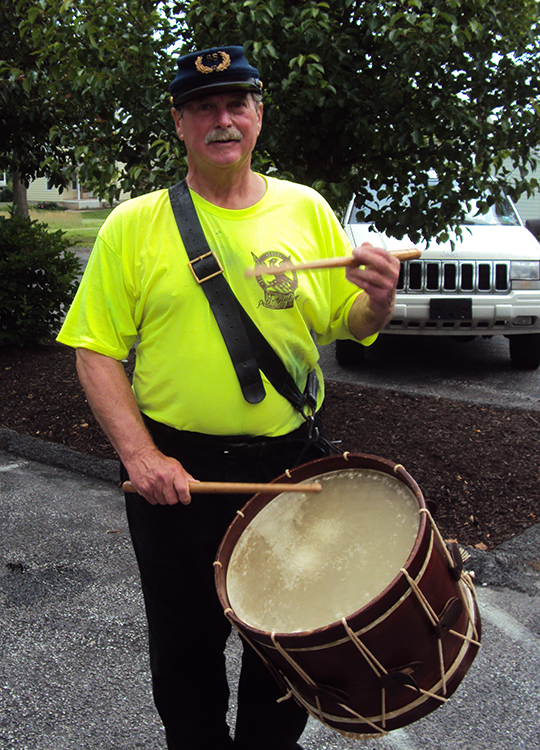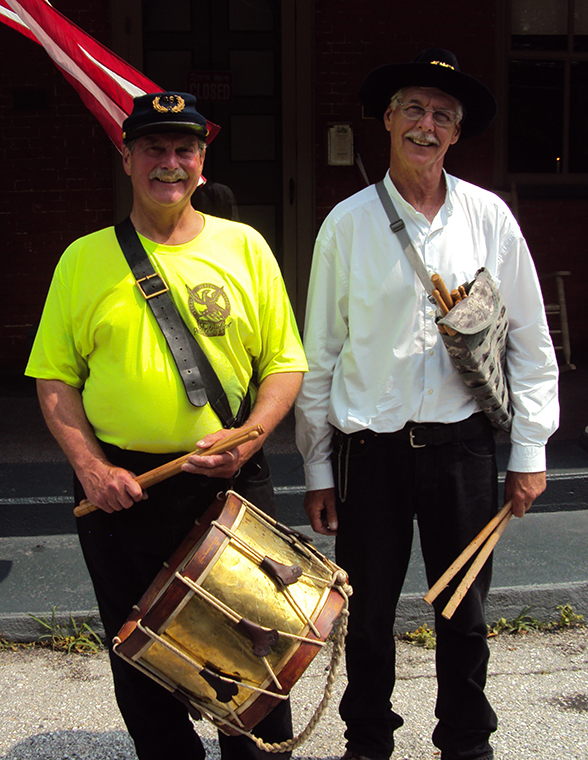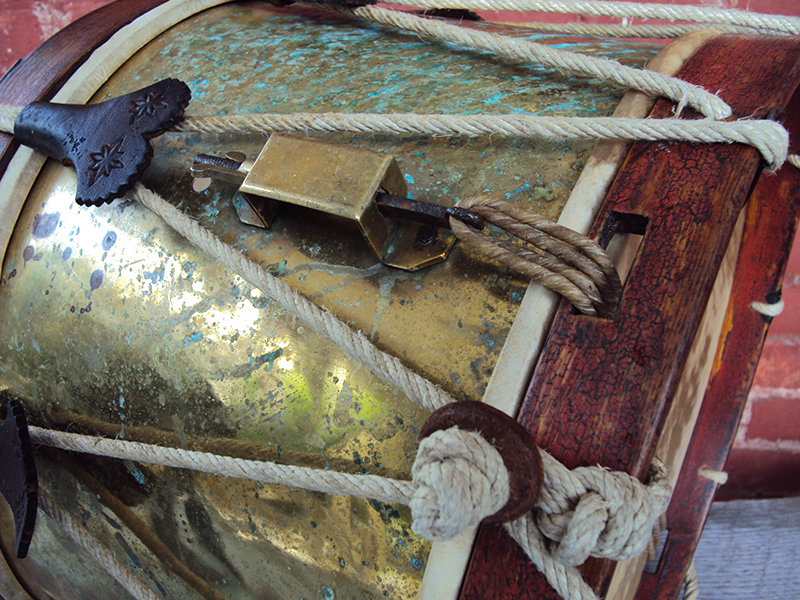Completely constructed of thick cut ash, this sturdy relic from the birth period of our American nation is wonderfully preserved, as should be in the case of such an early, historical piece. Formally of a New England estate, this very unique drum must have been recognized for the role it must have played during a very special time in history, and thus carefully protected from the destructiveness of time and abuse.
Read moreMaster Blaster
As with many drums of the 18th and 19 centuries, this full-barrel bass was more than likely hand crafted by a trunk and furniture maker, or possibly even a coach and carriage builder. The main tack pattern surrounding the sling attachments is very common to that which was used on the lids of storage or travel trunks of the era. A drum maker would normally have his own unique tack pattern to identify his work as opposed to a commonly used utilitarian tack design familiar to trunk builders. A secondary brass tack pattern of a circle within a circle is located surrounding the unreinforced vent hole.
Read moreThe Dragon Drum
Recently I was asked by some friends if I could design a drum with a Renaissance Faire crowd in mind. So in true CT Pro Percussion / Charter Oak Drums fashion when left to our own devices, came up with the dragon drum that you see here. The prototype you see here has been made with a reclaimed shell and hoops and is fitted with calfskin heads both top and bottom along with custom ears. We will be offering this drum as a regular production item with choices of color including red/black, green/black, yellow,black or solid black as well as your choice of plastic, calfskin or Kevlar heads. Matt Alling CT Pro Percussion www.ctpropercussion.com
Read moreA Good Rattling Instrument
Maker: Abner D. StevensCirca: Late 1790’s-Early 1800’s Dimensions: 14.5”(h) x 16.5”(dia.)
As hostilities with England became a not too distant memory, the inhabitants of the new American Nation now had the task of rebuilding not only the physical damage caused by no less than seven years of a very personal war, but had an entire economy to repair as well. Born in a small New England town in 1770, a young and industrious Abner D. Stevens started making drums at his shop in Hancock, Massachusetts, in 1794 as his principle means of income.
Read moreDrumming in the Shadow of Revolution
Maker: S.D.C.Dated: 1794 Dimensions: 11”(h) x 15.5”(dia)
In the years of George Washington’s presidency, America faced increasing pressure and challenges on the frontier from hostile Indian tribes and the remnants of the British Army. Included in the terms of the Treaty of Paris, 1783, which officially ended the Revolution, Great Britain ceded the lands of the Old Northwest Territory to the United States. This area included most of modern Ohio, Indiana, Michigan, Wisconsin as well as part of Minnesota. However, the indigenous people of the territory rejected the notion that they no longer owned their land. The result was the Northwest Indian Wars.
Playing on the subconscious of the people of the new American nation was the idea that a large standing army was somewhat of a morale wrong. They had just fought a seven year war to evict the British army from their homes. This ideology brought about an under strengthened force comprised of one regiment: the 1st United States Regiment. Recruitment started in 1784 with two companies of artillery from the recently disbanded Continental Army. The 1st United States Regiment comprised of approximately seven hundred men and was all that there was, with the exception of the militia, to protect the entire frontier. Eventually a second regiment of similar strength was raised. England, as well as the rest of the world, could hardly take the new and seemingly weak American nation seriously. This resulted in Great Britain not evacuating the forts it occupied in the Territory as per the terms of the treaty. Hoping that America would fail, Britain encouraged the local tribes to band together and to continue to harass American settlers on the frontier. This was especially the case in the Ohio Territory of the Old Northwest.
By 1791, the American Army had suffered a string of loses culminating in the worst defeat at the hands of Native American Tribes. In the Autumn of 1791, General Arthur St. Clair took 320 men of the U.S. 1st Regiment and over 1100 militia north along the western border of Ohio. Near Fort Recovery, the ill-trained force met with disaster at the hands of the Indians Western Confederacy. There the Army suffered nearly one thousand casualties, including over six hundred dead. Interestingly, included with the battle reports, is the remark that “the Army had lost every drum.”
1794 brought final victory and a relative calmness to the Territory with General Anthony Wayne’s victory at Fallen Timbers on August 20, located in western Ohio. Wayne’s new army, the Legion of the United States, was an extremely well trained force. The Treaty of Greenville in 1795 ceded much of present day Ohio to the U.S. Into this turbulent environment, this drum was made.
In 1794, there were not that many drums left available for use. Built by hand in the cottage industry style of the day, this drum exhibits many of the characteristics of very early American drums.
The shell is made of a single ply of rough-cut oak. On the inside of the shell, there are vertical cuts in the wood to help in the bending process of this thick ply of very strong oak. The two heavy counter hoops are also made of oak strips. Both the shell and the counter hoops are joined by thick scarf joints and fastened by hand-made iron nails and natural glue. The shell was painted entirely blue while the counter hoops have faint remnants of red and blue or black paint as well as old varnish. They may have been painted more than once over the years. The over-all style is very reminiscent of the time. The only adornment on the shell is two brass tacks which appear vertical, top and bottom to the simple, unreinforced vent hole. As with the rest of the shell, they are painted over in blue.
Hand-cut into the bottom of the shell are two snare beds. The bottom counter hoop hasn’t any snare gates, but there is evidence that the drum once sported thick gut snares as the indentations in the bottom of the hoop testify. The most popular method of affixing snares at the time was to simply pinch the two ends of the snares between the drum and counter hoop. The only real way to adjust the snare tension on the head was to pull down on the ropes via the leather ears, sandwiching everything together.
Glued inside the shell, are two paper labels. The first, and oldest of the two, is the maker’s label. Hand written in the old brown of “iron pen,” it simply identifies the maker as “S.D.C.,” and the year “1794.” The second label is type printed and belongs to Frederick Blume. Blume was a small scale maker of pianos, organs, and melodeons and began his career in Pittsburg, PA around 1840. In 1859, he moved his business to 54 Chatham Street, New York City.
Blume’s label reads: “Drums and Trumpets. / Flutes, Violins, Guitars, and musical instruments of / every description. Send stamp for price list. Silk violin / strings, 25c., mailed. Frederick Blume. 208 Bowery.”
Frederick Blume moved his shop to 208 Bowery Street, NYC in 1861, during the Civil War. It is presumable that this drum was reconditioned for use during the War, hence the label. It is also presumable that at this time, it was cut down in height by about three inches to its present height of eleven inches. The presumption that the drum shell was originally about fourteen inches coincides with several irregularities with the shell.
First is that the vent hole is off-centered top and bottom by three inches. Normally the vent would be centered on the shell. The second clue is that there are two different styles of glue rings inside the drum. Made of a different type of wood and obviously made by a different craftsman, it also uses machine made nails which were available around the time of the War, instead of the handmade iron nails present in the rest of the drum. The original glue ring is made of the same wood as the shell and is of a completely different style, and utilizes the same hand-made nails found elsewhere on the drum.
By the time of the Civil War, smaller drums were coming into style and many of the old drums were being cut down to accommodate the trends of the time.
When this old tub came into the collection, the first thought was to keep it in relic condition. After a thorough examination, I realized it was a victim of hard use and abuse. It was a complete catastrophe. There were four different types of leather ears, the most recent circa 1900. Both heads were broken. The snare head was made of a material that resembled cloth, with a pitch-like black coating on the inside that made me wonder if it was even a drum part. The snares were also missing and there were two different types of rope that were spliced together with black thread. When I took the drum apart, I found it was also put together upside down. The newer of the two glue rings was coming off the shell and there was some breakage involved.
The restoration included nine new period correct, handmade leather ears; repair of the glue ring and flesh hoops; new calf skin heads; four old-stock cat gut snares from my old parts box; new cotton rope and a leather rope washer; a hand-made wrought iron drum sling attachment ring and leather lacing; and a thorough cleaning. Over-all condition of the drum is very sound and is in perfect playing condition. It’s a great “rattler!”
Accompanying the drum is a very nice pair of period oak drum sticks, correct in every manner to those common to the eighteenth century. They measure 17 ½” in length and are ¾” in diameter at the butt. As with most known sticks common to the era, they tapper gracefully from the butt all the way down to the “acorn” style tips. Attached to each stick is a heavy, hand-hammered pewter end cap. They are more than likely, original to the drum.
The fact that this drum even exists is amazing, let alone its ability to be played. The original unit is unknown as well as who may have played it over the years. There are those authorities in the historic antique community that believe that it may have originally been a Navy drum. It certainly spent time in the army or militia at one point or another. Use during the Civil War is also very probable. The period into which it was made and initially used was a period of tremendous unrest and uncertainty on the frontier, as well as on the waters of America. For an entire generation, it was a time that was lived somewhat optimistically in the shadow of the Revolution.
From Lancaster County, PA... thoughts from the shop.
- Brian Hill
X Still Marks The Spot
Maker: Henry EiseleCirca: 1890’s-early 1900’s Dimensions: 12”(h) x 16”(dia.)
One day, back in the day, while attending my good friend Jack Lawton’s PA Vintage Drum Show in Sunbury, I first met another good friend and fellow collector, Jack Ricciutti. Among the many wonderful vintage drums Jack had brought to the show was an incredible 1926, 4” x 14” Leedy Elite snare drum. Not only was this drum beautifully engraved and trimmed in Art Gold, it also sounded great. Not having enough pocket cash with me that day to make the deal, I took Jack’s phone number and some notes on the drum. I also learned that Jack had a couple Slingerland Radio King WMP snare drums at his home in New Jersey.
Back home I started looking into Leedy Elites and Radio Kings, making a few phone calls to people in the know and decided the Leedy would be a wise investment to my collection. A few months later I made the call to Jack and we agreed to meet at his home in a week and do the deal on the Leedy.
At Jacks home we made our way to the studio where there were drums everywhere. He soon presented me with the drum I had come for and we eventually started talking about the Radio Kings he had mentioned back at the drum show. They were from the late 1930s and early 40s and in great condition. We soon made a deal on them and I happily added them to my treasure trove. As I continued to examine my two new and unexpected finds, I hadn’t noticed that Jack had left the room. When he returned, he placed on the floor at my feet an old rope tension drum. During our prior conversations, I had mentioned that I was an old drum corps kid from DCA and DCI. What Jack had not only was a very cool old rope drum, but one that was identified from the artwork on the shell as the “Garfield Corps.” Being a former DCI member, that name rang home with me.
I decided that this extra drum should also come home with me and we settled on a price. Jack sent me on my way home with a nice bottle of wine and a handshake that would be repeated often. The trip back home was filled with the satisfaction that only a car load of new vintage drums can bring.
While the Leedy and Slingerland drums were an incredible score, I was entirely consumed with the intrigue of what I might uncover on the “Garfield Corps” drum, which today is another “X” in the hunt for my next perfect drum.
Since this rope drum was previously restored by Jack Lawton, there was nothing to do but research and enjoy it. The paper maker’s label inside the drum identifies Henry Eisele of New York City as the maker. Eisele is listed as being established as a drum maker as early as 1862. He eventually became the successor to famed drum maker, William Sempf, who he worked with and perfected his trade. Eisele eventually took over Sempf’s business when he retired in the mid 1880s. The label reads: “Henry Eisele / Successor to Wm. Sempf / Manufacturer of / Bass and Snare Drums / 209 and 211 Grand Street, New York / N.B. – Drum Heads, Sticks, Cords, etc. / Constantly on Hand.” Eisele maintained this address listing from the mid-1880’s until the early 1900’s.
Built during a time of great innovation, this drum sports many of the modern features that make it one of the top-of-the-line rope tension models of its day. This includes the 10 metal-reinforced “break-away” style leather ears, sash rope, metal snare butt, and nickel plated metal rope hooks. The snare adjuster is the screw-type version that came to the market during the Civil War period. This adjuster type has the adjusting screw receiver mounted on the bottom counter-hoop. This always seems to put too much pressure on that hoop when tightening up the snare tension, forcing it away from the snare head. The bottom counter hoop, which in this case has fairly deep snare gates, is often too thin or weak and tends to negate the ability of that hoop to provide adequate pressure or tension on the snare head.
Eisele used an early form of plastic for the grommet of the vent hole. There were several advances in plastic technology available at this time and may help narrow down the date of manufacture. The first plastic was invented in 1862 and was known as Parkesine. Celluloid quickly followed in 1868. My first guess as to the identity of the material used for this grommet would be Bakelite, which was invented in 1897. This would help date this drum more accurately to 1897-1909. 1909 was also the last year Henry Eisele used that exact address.
The stained and varnished shell is made of a single ply of maple as are the varnished counter hoops which are all in very good shape. Placed in the center of the shell is an eagle and flag design that Eisele used quite often during this era. Placed directly on the eagle is a capital letter “B.” This is presumably for Bergen County, NJ. Also painted in large gold letters top and bottom is “GARFIELD CORPS.” This drum was probably not a military drum but rather part of a civilian drum corps or possibly a band. The exact origin still remains a mystery.
The most famous and longest running of the Garfield marching units was formed in 1934 as the Holy Name Cadets, a Catholic youth group drum and bugle corps. They eventually became known as the Garfield Cadets Drum & Bugle Corps. Later incarnations where known as the Cadets of Bergen County, The Cadets of Garfield, and finally just The Cadets. Despite the name changes, they have become one of the longest running and most successful drum corps in the world with ten DCI World Championships. This drum, no doubt, is somewhat of an ancestor to this most famous of drum corps.
In this case, the “X,” or the unknown factor in my trip to New Jersey, turned out to be a “ten.” Not only did I find that special unexpected drum, I made a friend for life who also shares a mutual love for the percussive arts. I was also reminded that “X” sometimes still does mark the spot for treasure, as the Garfield drum not only reconnected me with my drum corps past, but also rekindled of my love affair with rope tension drums and the history that surrounds them.
From Lancaster County, PA…..Thoughts from the Shop.
-Brian Hill
Enter the Bloody Wheatfield
Maker: Charles E. TownCirca: 1853-1859 Dimensions: 14.5”(h) x 16”(dia.)
The ground must certainly still have been soaked from the recent rain as a young 16 year old named John H. Rosensteel ventured out from his home in the vicinity of the Round Tops south of Gettysburg. Along with many other local residents, he was there to start the gruesome task of burying the dead. It was Sunday, July 5th 1863. The Confederate Army had quit the field late the day before. They started the long journey back to Virginia during the night in a drenching downpour that had washed away the blood but could not hide the destruction of three days of savage fighting. John’s home had become part of a nightmarish scene caused by the destructive power of over 170,000 battling soldiers. One of the first of the dead that he encountered was a young Confederate soldier about his own age.
John picked up the gun lying beside him and decided to keep it as a souvenir. This gun was the first piece of what would become the famed Rosensteel Collection; a collection that would become the family’s legacy and would eventually number well over 43,000 pieces.
As John continued to collect the debris of the battlefield, he eventually came across an abandoned eagle drum somewhere in the vicinity of the Wheatfield and back toward Little Round Top. The drum belonged to one of the drummers of the U.S. Regular Army. The Fifth Army Corps had within its ranks of the 2nd Division two brigades of U.S. Regular Army Infantry battalions commanded by General Romeyn B. Ayres, which were brought up in support of General Daniel Sickles Third Corps line. The Third Corps was being pummeled by Longstreet’s sledgehammer attacks during the evening of the second day. Ayers two brigades of U.S. Infantry Regulars contained elements of the 2nd, 3rd, 4th, 6th, 7th, 10th, 11th, 12th, 14th, and 17th Regiments. These two brigades were commanded by Col. Hannibal Day and Col. Sidney Burbank.
 Around 5:00 p.m. on July 2nd, the two brigades crossed Plum Run in an area of what would soon become known as the Valley of Death, moving west to the crest of a rocky wooded ridge, and then advanced through the woods to the edge of the Wheat Field. They initially took position behind a low stone wall, just as units from the U. S. Second Corps were being pushed out with heavy losses. The U.S. Regulars then entered the fray and engaged the veteran legions of Confederate General Wofford’s Georgia Brigade. Both sides suffered frightening losses, but it was the Regulars who took the brunt of it, suffering 50% casualties. Their exodus was no rout; the Regulars marched from the field in good order taking heavy losses, turning to fire at the Georgians as they were pushed back over rough terrain to the Little Round Top line. Sometime during this encounter with the enemy this drum was lost for some unknown reason, only to be picked up a few days later and added to what would become the largest private collection of Gettysburg relics.
Around 5:00 p.m. on July 2nd, the two brigades crossed Plum Run in an area of what would soon become known as the Valley of Death, moving west to the crest of a rocky wooded ridge, and then advanced through the woods to the edge of the Wheat Field. They initially took position behind a low stone wall, just as units from the U. S. Second Corps were being pushed out with heavy losses. The U.S. Regulars then entered the fray and engaged the veteran legions of Confederate General Wofford’s Georgia Brigade. Both sides suffered frightening losses, but it was the Regulars who took the brunt of it, suffering 50% casualties. Their exodus was no rout; the Regulars marched from the field in good order taking heavy losses, turning to fire at the Georgians as they were pushed back over rough terrain to the Little Round Top line. Sometime during this encounter with the enemy this drum was lost for some unknown reason, only to be picked up a few days later and added to what would become the largest private collection of Gettysburg relics.
Ten years before this bloody exchange, Charles E. Town of Bath Maine, received the first of two contracts during the 1850s to make drums for the United States Army. The contract of 1853 was for 100 drums for the Infantry. Then in 1859 he received a second contract for 19 drums for the Artillery and an additional 56 drums for the Infantry. This drum is one of the 156 drums Town made for the U. S. Infantry during the 1850s. Inside the drum, opposite the vent hole, is a paper maker’s label in very good condition which simply states: “DRUMS / Made and Sold by / Charles E. Town, / Bath, Maine.”
Sitting on the blue field for infantry is a primitive, hand painted version of the United States Arms…..sometimes known for the central figure as an “eagle” or “eagle drum.” In comparing this version of the Arms with other known Town drums, it seems quite plausible that Town used a stencil for the outline and had the rest hand painted by a skilled painter. The style of the Arms certainly dates this drum to the 1850s.
The shell is made of a single ply of ash wood which retains much of the original stain and varnish. Town reinforced the seam, formed by a scarf joint, with his own unique brass tack pattern of a rectangle with a vertical diamond-circle-diamond within and centered on the unreinforced vent hole. The maple counter hoops also retain much of the original red sponged paint. Interestingly, there are severe water stains on the back portion of the shell that give evidence of the acrid nature of the rain that fell on the 4th of July as this drum sat quietly where it fell on the field only days prior to its retrieval by Rosensteel. There is no evidence that this drum ever had a mechanical snare adjuster mounted to it; the snares were simply run between the head and the lower counter hoop and pulled by hand to increase the tension.
Since this drum was in very good overall condition, it was decided to make it a player. With the addition of new gut snares and a leather snare butt, one leather rope washer and a metal ring secured by a black leather lace to attach to a drum sling, only a light cleaning was in order. The drum had been partially restored some years prior by an able, unidentified person who installed new skins, 10 leather ears and linen rope.
This drum has an enormous sound that carries the distance when tensioned up and played with the proper sticks - obviously heard above the din and roar of battle.
In 1888, John Rosensteel started the Round Top Museum in honor of the 25th Anniversary of the Battle. John eventually passed custody of his collection to his nephew, George Rosensteel, who also remained dedicated to educating the public about the epic battle. After the 50th Anniversary of 1913, George expanded with the National Museum. By 1921 he had moved it all to the location of what would become the now former National Parks Service Visitor Center and Museum, located across the road from the Cemetery. Within this building which was built on the premises of the old Gettysburg town dump, the Rosensteel family lived and housed the museum containing the huge collection, which was open to the public. It was George’s son, Joseph Rosensteel, who created the famous Gettysburg Electric Map in 1938, which used small light bulbs to show the flow of troops during the three day battle. Joseph died the following year from cancer.
In 1971, the Rosensteel family sold the property to the National Park Service for $2.6 million. The bulk of the artifact collection was given to the “people of the United States.” Touring the Visitor Center’s Museum at Gettysburg, one can see the core of the old “Rosensteel Collection!” However, the Rosensteels did retain a portion of the collection they deemed as “special.” This drum was one of those “special” pieces held by Larry and Angi Rosensteel Eckert, George’s daughter. The Eckerts passed the drum to friend and collector John Fenstermacher, Esq. and his wife Peggy for legal services he performed for them while working with the National Parks Service. With Johns passing, Peggy sold the drum to the Hill Collection.
With the history of this drum’s incredible collection status and the events leading up to the Battle and its retrieval from the southern end of the Gettysburg Battlefield, the details surrounding this drum are epic and monumental to say the least. The shell still bears testimony to this with the numerous scars that are visible. The identity and ultimate fate of the anonymous lad who carried it on to a field which changed hands six times in a matter of only a few hours will remain unknown. It was a field so violent that it transformed into a “whirlpool of death.” One veteran of the battle later remarked of the U.S. Regulars who fought in the Bloody Wheatfield, “for two years they showed us how to act like soldiers... at Gettysburg, they showed us how to die like soldiers.”
From Lancaster County, PA... thoughts from the shop.
Brian Hill brisoundperc@yahoo.com
The Last Ten Miles
One bright day in early Spring, 2013, I met up with friend and fellow collector/ historian, Craig Caba, at his home in Central PA, to look at and talk about some of our old drums. Our conversation soon found its way to the project of another mutual friend, Jim Smith, known affectionately as, the "Yankee Drummer." Jim had realized that there wasn't a memorial to the Civil War Musician, and creating one would be rather expensive. To help fund this endeavor, he had the idea of selling commemorative replicas of Civil War drum sticks made from the wood of "witness trees"…..trees that were present and alive on the Gettysburg Battlefield during the time of the Battle in 1863.
At the suggestion of friends, Jim also decided to recreate the little known, but epic journey of a certain veteran drummer of the "Late Hostilities."
That certain veteran was Peter Guibert, Drummer of Co. F, 74th PA, who at 70 years old, marched with his old drum to the 50th Anniversary Reunion of the Battle of Gettysburg. Jim, also 70 years old, would recreate the march of 200 miles from the Pittsburg area to Gettysburg in 19 days, this time to honor Peter Guibert and celebrate the 150th Anniversary of the Battle. Jim would use the same drum that Guibert used while in the War, and on his journey in 1913…….. 100 years ago to the day! Craig and I eagerly decided we would accept Jim's invitation to join him in Cashtown, for the last ten miles of this historic journey to Gettysburg.
Born in Germany on January 4, 1844, Peter Guibert, of Allegheny County, PA, mustered into Company F, 74th PA at Camp Wilkins, near Pittsburg, on September 14, 1861, as a musician. During the next three years, these men fought and died in different theaters of the War, and for a period of time, in the Army of the Potomac. Before the end of 1862, the 74th eventually found itself as part of their former regimental commander, Col. Schimmelpfennig's, new brigade. General Schimmelpfennig's brigade was in Schurz's division and part of Howard's 11th Corps, Army of the Potomac. At Chacellorsville, VA, in May, 1863, they were heavily engaged and on the second day of fighting, they were placed on the left of the 11th Corps, which was on the Union right. When the regiments on the far right belonging to the 1st Division broke, the 74th, along with other regiments of its brigade, changed fronts and held off the Confederates of General T.J. "Stonewall" Jackson, losing 52 men. Less than two months later, they were again in the thick of it at Gettysburg.
The 74th, still part of Howard's 11th Corps, found itself on the Union right during the fighting of July 1, 1863. Placed on the 11th Corps left, they were soon caught up in the rout that broke the Union right. Falling back through Gettysburg, they reformed on Cemetery Hill where they remained for the rest of the battle. During the remainder of the War, the 74th saw service in South Carolina and the Washington defenses. After mustering out of the 74th, Guibert soon enlisted in Co. D, 77th PA, in February, 1865, again as a musician, and headed for Tennessee until mustering out in August, 1865.
Following the War, Peter Guibert returned to civilian life in Allegheny County near Pittsburg and worked as barber. 1913 brought about the 50th Anniversary of the Battle of Gettysburg. That year, Peter turned 70 years old and held a strong desire to attend the anniversary ceremonies of the epic battle he participated in 50 years ago. Being the largest and most costly of the Civil War's battles, he knew veterans from all over the country would attend. Instead of taking a train, horse, or automobile, he decided to walk the distance. He would be accompanied on this journey by his friend, 62 year old John Conroy, an Army veteran, (1872-77) who fought Comanche Indians in Texas. On May 26th, 1913, they stepped off from the steps of what was then the Allegheny City Hall at 9:00 a.m. Ahead were 200 miles of some of the most challenging ridges and heights of Pennsylvania's Allegheny and Appalachian Mountains, chief among them was the Bald Knob Summit, with a height exceeding 2900 ft., and the Tuscarora Mountain (2458 ft.), among many others.
On the march, Guibert would beat his drum and entertain the folks along the way, many times in return for refreshments and lodging. On the morning of June 12th, the Guibert party departed from the Cashtown Inn, Cashtown PA, where they had spent the night, and began the last ten miles to Gettysburg. Completing the trek in 19 days, the two weary travelers entered the edge of Gettysburg on morning of June 13th where they were picked up by the Bell Telephone wagon and given a ride to the center of town.
There, they played a free concert and stayed at the City Hotel (now the James Getty Hotel), located on the square, until after the reunion festivities were complete. While in Gettysburg, Peter seems to have been quite active as several creditable accounts have him entertaining many of the inhabitants and veterans; apparently earning enough money to fund his stay. Peter also took the opportunity to join, and be photographed with, veteran musicians of the Union and Confederate ranks for a one-time performance of "The Blue and Grey Reunion Band of 1913." He was also featured as the opening act for the epic silent film: "The Battle of Gettysburg."
Jim Smith acquired the Guibert drum directly from a member of the Guibert family, niece Betty Mower, of Delmont. She had learned of the Yankee Drummer through a local newspaper article in 1982. The old Civil War drum had been passed to her through the family and had languished in attics for decades. Jim bought the drum along with an old newspaper article about the 1913 trek and then met with several members of the Guibert family over time. Through diligent work, he was able to piece together much of the life of Peter Guibert and even found additional period newspaper articles about the trek and his time spent in Gettysburg. However, Jim's commitment to the trek began during a visit with Peter's Grandson, Clarence Guibert, who at one point "expressed concern that peter's name was not listed in the official PA records in Gettysburg." Jim later found Guibert's name in the records...misspelled...the error has since been corrected.
Peter Guibert's field drum was one of the newer designs available to the drummers of the era. The shell was constructed of solid brass and is somewhat heavy. It has a very efficient, brass snare adjustor that isn't the frequent norm of what most period drums utilized. Jim has since made small metal parts that over-lay the wooded hoops at the point over of the rope holes, to help protect against the wear and pressure of the ropes bearing down on these old hoops. Other replacement parts include hemp rope, leather ears, skins and snares.
With no makers label or any markings in or on the shell, the maker remains unknown. However, a brass shell construction at this time suggests that the drum was imported from Europe.
The sound is exceptionally full and projects well, especially when played with heavy, robust sticks. When Jim acquired the drum, it had a broken head with an old silver-tipped stick inside. He then fully restored the drum to playing condition and has kept it in that condition.
According to local newspaper accounts, Peter Guibert and John Conroy not only trudged along with this old field drum, but a rope tension bass drum and pedal, fife, calliope, harmonica, slide whistle, and various other musical instruments for the purpose of Guibert performing as a "one-man-band," as he "was well-known as an entertainer." Jim also included an old rope tension bass drum as well as other musical instruments in keeping with the spirit of the trek.
After 190 miles on the road, Jim and his friend, Ray Zimmerman (who plays the part of John Conroy) arrived at the Cashtown Inn where they met up with Craig and me. On this day, the Peter Guibert Trek of 2013 had a slightly larger entourage of seven people, including Len DeCarlo (trek coordinator), Duane Myers, and Dick Mizikar, along with two vehicles. I had brought along my circa 1840 Porter Blanchard field drum so I could play along with Jim for this final 10 mile leg of the journey. While at the Cashtown Inn, Jim and I played our drums for each other, as well as together. One thing about playing authentic rope tension drums with calf skins and gut snares is that you clearly hear all three aspects of the drum: There is the basic sound of the drum, and the sound of the snares, but then you hear the sound of the "drone," which is something I think that's missing from drums with plastic heads, synthetic snares, and muffling. The sound of these old drums really "carries" outdoors.
We stepped off in mid-morning... Jim, "Conroy," Craig and I, along with our escort vehicles, and headed east down Old Route 30, "The Lincoln Highway," through Cashtown... The same route that Confederates under Lt. General A.P. Hill used 150 years ago, as they headed east to Gettysburg, playing a cadence as we went. In doing so, the feeling of history was almost over-whelming as we felt the trodden path of so many other travelers of the past.
The day was extremely hot and humid...as I imagine it was in 1863 and in 1913. As the sun rose high in the sky, I could feel its effects start as we played our drums on the hot road. We stopped at every waving flag and cemetery along the way and properly saluted with drum and hand. The dogs did not bother with us as I wondered if the drums intimidated them. One of the stranger things we learned was that cows apparently like drums! At every instant of the sound of the drum, herds of cows would line up along the fences and watch...moving along as we did...pleasantly animated.
As we progressed, residents would venture out to see what the racket was all about, many times offering us drinks and sandwiches, while eagerly soaking up tales of the trek. At one point, we heard the sound of a drum set coming from a house along the route. We decided to serenade our newly found compatriot with a rousing and spirited round of Three Camps. The commotion worked as the drummer from within soon appeared on the front porch and applauded our completion of the piece. At other points we were saluted by the local veterans, who we respectfully saluted back. Passing vehicles would honk and wave. Everybody cheered. And so it was as the Peter Guibert Trek proceeded along the 200 hundred mile route that seemed full of goodwill.
Jim Smith, at 70 years of age, had completed one of the most challenging and epic journeys to honor any veteran of the "Late War" in grand style. The combination of heat, humidity, rain, and wind (or lack of it) only added to the reality of walking such long distances with a drum. Another daunting danger was the traffic which made safety along the way a major concern. There were no major mishaps in this regard, as the most common occurrence seemed to be the constant honking of horns and waves of well-wishers in general. Through it all, Jims pace, style, and playing were precise and purposeful, and being a master drummer and historian, he knew all the music and calls.
The route was full of high elevations and valleys and as Craig and I would occasionally lag behind talking, we could see that Jim (and "Conroy") repeatedly would take each hill like a Roosevelt! Jim Smith appeared larger than life on that day. In keeping true to the form of the original trek, Ray had quietly arranged to have a wagon of the Bell Telephone Company waiting for them as a surprise on the morning June 13th as they prepared to take Gettysburg, just as Peter Guibert and John Conroy did 100 years ago to the day!
Arriving at noon in the Gettysburg Square, they played a free concert by the James Getty Hotel and met with well-wishers and family. Also joining them was friend and fellow drummer John Beck, President of the Percussive Arts Society, who was also at the initial step-off in Pittsburg. Later that day, Jim delivered dirt from Peter Guibert's grave to the 74th PA regimental marker on the Battlefield. As did Peter, Jim stayed at the Hotel on the square and remanded in the area until much of the festivities came to a close.
Heat, fatigue, and dehydration played a large part on the march for military drummers and soldiers alike. This is something that we would be reminded of during the Trek and celebrations leading up to and during the 150th Anniversary of the Battle of Gettysburg, as well as with the previous reunions and the Battle itself. During this time, several drummers and bandsmen "went down with the heat" and needed to be transported to the local hospital.
I was quickly reminded that being a drummer during the "Late Hostilities" was no easy task. During this last ten miles of Jim's Trek, Craig and I learned of so many things that affected the daily life of early drummers and soldiers while on the march.
Peter Guibert died on December 7, 1933, at age 89. He had played music all of his life, as the music was deep within him. Known as the "Wizard of the Drums" and the "Master of Military Music"...names that a "God Father" of the rope drum community the likes of Jim Smith, could easy personify without fault. But Jim, the Yankee Drummer, had earned his own new moniker as he entered Gettysburg right on time, the very same day as did Peter Guibert, exactly 100 years ago...now we refer to him as "Jim Smith: Iron Man of the Alleghenies."
In the end, the big question here is...Why did Peter Guibert decide to walk the 200 miles to Gettysburg?...Especially when the government offered free train passes to any Civil War veteran wishing to attend the reunion. The only reason offered by Smith is that Guibert apparently walked everywhere! With the Peter Guibert Trek of 2013 behind us, I find myself happily reminiscing with Craig as we look back on and talk about the privilege and the experience we had partaking in recreating this historic, yet telling journey. We also embraced the camaraderie we found in all who took part in making this event a huge success. "There are many historical artifacts out there that have interesting stories to tell but rarely get the opportunity"...Jim Smith has taken the opportunity to do so and has marched with it and made it so. Our special, indebted thanks to Jim for offering us the opportunity to share with him ... The Last Ten Miles.
From Lancaster County, PA, Thoughts from the Shop....
Brian Hill


